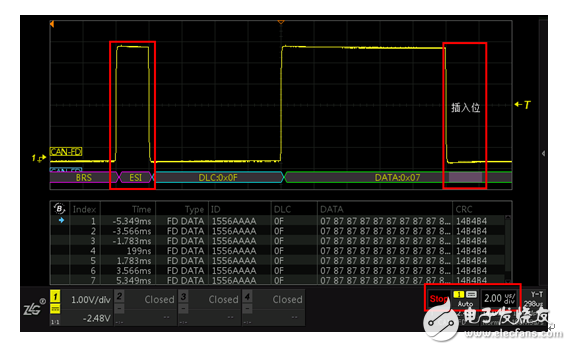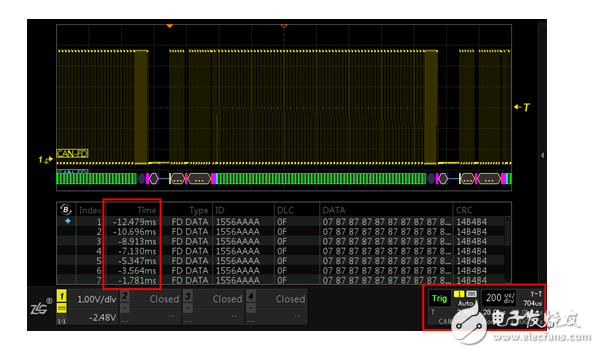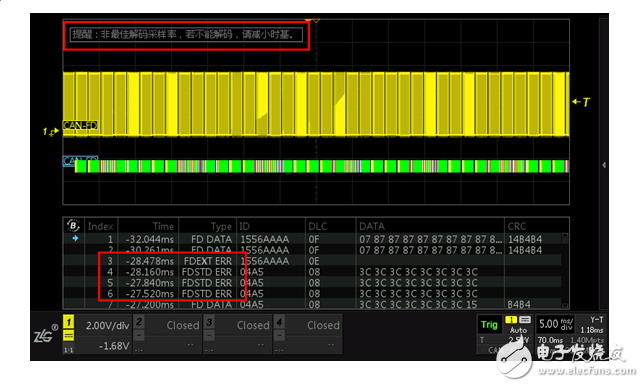Abstract: All models of ZDS oscilloscopes support full memory decoding, and can be supported by downloading the latest firmware. The new features are more compatible with the deep memory features unique to the ZDS oscilloscope, allowing for a wider range of decoding. Let's take a look at the changes that new features bring to us. We know that protocol decoding is a very important function in protocol analysis. Its practicality depends on the accuracy of decoding, decoding range and decoding speed. The decoding range and decoding speed are contradictory, and it is difficult to have both. In the previous decoding scheme, we limited the decoding range to a certain width of data, so as to ensure that the decoding result can be quickly responded to the user. However, we found that we are often not satisfied with this range during the use, but we can not expand the scope of decoding without limit (free expansion will affect the decoding speed). We can't give up the existing fast decoding user experience. The new feature is created to solve this fish and bear paw problem. It contains three aspects of change. First, the waveform can be decoded normally after amplifying the waveform In the new scenario, we no longer need to consider the impact of the decoding range caused by scaling or moving the waveform horizontally, nor do we need to consider "how much data is there outside the screen." The range of our decoding will change intelligently with the amplification of the waveform. It is no longer a simple limitation of the decoding range. Now we can enlarge the waveform to a very subtle place and still decode normally. Figure 1 decoding details zoom As shown in Figure 1, the waveform of CAN-FD is being decoded. In the pause mode, we amplify the waveform from 1ms/div to 2us/div. The values ​​of ESI, insertion bit, and DLC and DATA can be clearly and accurately observed. We can see the details of the decoding. Second, the decoding will be based on the data of the full memory A major feature of ZDS oscilloscopes is deep memory, and a fixed decoding range will limit the application of this feature, resulting in most of the data in deep memory can not be used for decoding. In the new feature, this situation will change, we can set the memory depth to be large, the system will dynamically adjust the decoding range according to the characteristics of the protocol baud rate, etc. In the most ideal case, we will extend the decoding range to the entire memory, and This feature is available in both Run and Stop modes and is no longer limited to Stop! Figure 2 full memory decoding We set the storage depth to 28M, and the time span of the entire in-memory data is -14ms ~ 14ms. From the event table in Figure 2, we can see that the position of the first frame CAN-FD is -12.479ms, that is, at the beginning of the memory data, the full memory decoding has been achieved. Of course, this powerful full memory decoding is also subject to certain conditions, which we will mention in the following. Third, the system will judge the best decoding situation The new features are based on the idea of ​​maintaining the original decoding speed and maximizing the decoding range. This means that the decoding of large amounts of data is based on a certain proportion of sample points after decimation (the less the amount of data used for decoding, the faster the decoding). The system compares the characteristics of the protocol (baud rate, etc.) with the characteristics of the snapshot to determine whether the decoding is risky (decoding error or risk of not decoding). For example, in some cases, the interval at which the snapshots occur is large, so that the sampling rate actually used for decoding is insufficient, and the system will give a prompt. Figure 3 non-optimal decoding tips As shown in Figure 3, the prompt appears at the top left of the screen. As can be seen from the event table, a partially erroneously decoded frame appears in the middle of the waveform. This error is caused by insufficient decoding sampling rate. When you need to pay attention, when this prompt appears, the decoding does not necessarily go wrong, it is a warning. And when we really can't decode normally, we only need to follow the system prompts (as shown in the figure should reduce the time base), we can return to the best decoding state. This is also the full memory decoding constraint described in the second point. How did we get both the fish and the bear's paw? Keeping the amount of data used for decoding unchanged, you can ensure that the decoding speed does not change greatly. On this basis, we can spread the data range more evenly and reasonably into the memory, which can broaden the decoding range. In the new design, we will intelligently extract the memory data according to the characteristics of the protocol baud rate, dynamically adjust the sampling interval, and achieve the purpose of covering a wider decoding range as much as possible in the case of constant data volume. The new characteristics of both fish and bear's paw. Generally, there are: parallel port cable, USB cable, and network cabledd Dongguan Bofan technology Co., LTD , https://www.pengliandz.com

